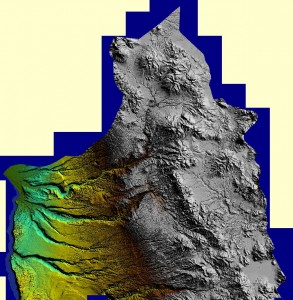Cartography in the 21st century has evolved from traditional static paper maps to dynamic maps updated on a frequent basis. In this new mapping paradigm, locational accuracy is a key aspect for identifying features on the ground. Traditional maps sought to depict features on the ground in two dimensions and focused on accuracy of location, the “X” and “Y” directions on a horizontal plane. In the new mapping paradigm, where maps are increasingly used for variety of applications like line of sight analysis for urban planning, radio frequency propagation for new cell towers, building information modeling (BIM), and others, vertical accuracy in the “Z” direction is and increasingly critical dimension.

Elevation modeling can produce a range of products with varying levels of detail, including digital surface models (DSMs) and digital terrain model (DTMs). This blog focuses on the importance of vertical accuracy for DSMs. The figure below shows the difference between a DSM and a DTM.

In the past, contours (generalized elevation models) and digital elevation models were primarily derived from ground surveys, terrestrial scanners, GPS systems, and surveying instruments such as theodolites, that produced sparse data to represent a multi-dimensional view of the earth. For large-area elevation mapping, recent years have seen proliferation of geospatial technologies such as RADAR, IfSAR, LiDAR, and stereo imagery from aerial and satellite platforms used to create accurate elevation models.

The early 2000’s saw increasing adoption of IfSAR and LiDAR elevation models with 1 meter to 5 meter postings, to capture the elevation models. LiDAR sensors on aerial platforms were able to fly at slower speeds and lower elevations to capture multiple LiDAR returns at sub-meter resolution. During this time, there was also increased adoption of elevation models from aerial and satellite-based electro-optical (EO) sensors. Figure 4 shows an example of 2 meter posting elevation datasets from WorldView-2 satellite data as compared to SRTM (shuttle radar topography mission) 90 meter postings.

WorldView-3, Maxar’s newest satellite, launched in August 2014, can capture imagery at 30 cm resolution. This satellite, similar to its predecessors, including WorldView-1, WorldView-2 and GeoEye-1, has the ability to scan forward and backward, enabling the collection of stereo imagery that can be used to extract elevation models. With 30 cm spatial resolution, for the first time, satellite imagery can produce sub-15 cm elevation data that can compete with LiDAR datasets. A recent independent study from PhotoSat, used WorldView-3 stereo imagery and their proprietary techniques to extract an elevation model over a 144 sq km area in Southern California. PhotoSat’s bare earth elevation grid (DTM) was compared to a highly accurate LiDAR grid verifying that the vertical accuracy of the WorldView-3-derived elevations were better than 15 cm RMSE. With global coverage, the satellite industry can now provide LiDAR-quality elevation models at a scale and speed that is unmatched by other elevation processing technologies.